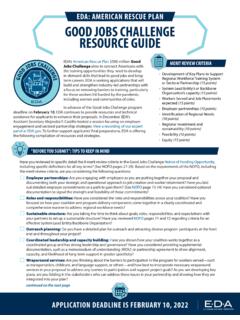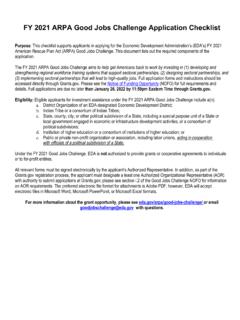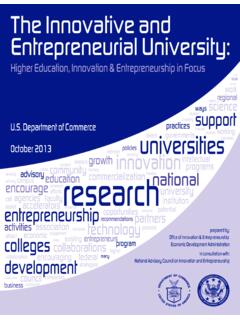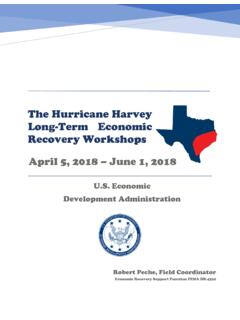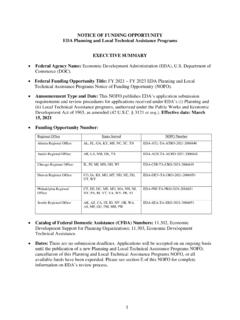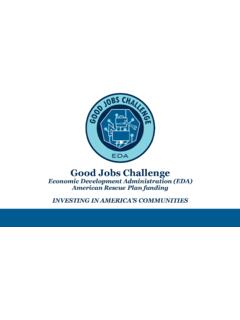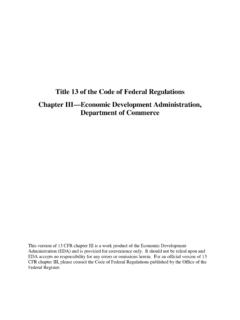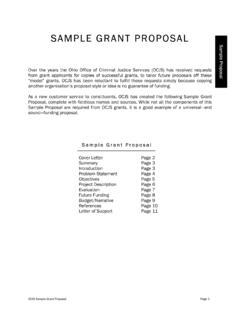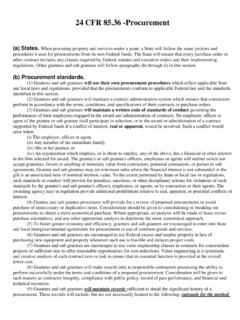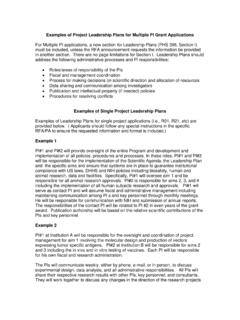Transcription of Good Jobs Challenge
1 August 27, 2021 good Jobs ChallengeEconomic Development Administration (EDA) American Rescue Plan fundingINVESTING IN AMERICA S COMMUNITIESA genda EDA's American Rescue Plan good Jobs Challenge overview Program Definitions Getting Started: Pre-application process Applicant Checklist Additional Resources and FAQsDescriptionNOFOs1 Build Back Better Regional ChallengeTransform 20-30 economically distressed regions through substantial investment through groups of 3-8 projects, totaling ~$25-75M per region; open to proposals up to $100 MEconomic Adjustment AssistanceInvest in infrastructure, technical assistance, planning, and revolving loan programs through competitive grants available to every community4 Travel, Tourism, & Outdoor RecreationAccelerate communities impacted by COVID-related travel and tourism decline through state grants ($510M) and competitive grants ($240M)Statewide Planning, Research, & NetworksInvest in economic plans, research to assess the effectiveness of EDA's programs, andsupport for stakeholder communities around key EDA initiativesGood Jobs Challenge2 Establish or strengthen regional systems to train workers with in-demand skills through employer-driven training, supporting participants with wrap-around services and employer commitments to hire6 Indigenous Communities35 Additional Economic Adjustment Assistance funds to specifically support Indigenous communities$90M$1B$750M$500M$100M$500 MTotal American Rescue Plan funding: $ $500 millionfor the good Jobs ChallengeProgram Goal: Get Americans back to work by establishing or strengthening regional systems to train workers with in-demand skills through sectoral partnershipsProgrammatic focus: Job placement is key!
2 Industry partners and employers play a critical role Unemployed or underemployed workers from underserved communities Incumbent workers from underserved communities with opportunity for increased wages with targeted upskillingAwards: Between25 and 50 awards at ~$5-25 million eachGrant Rate: Projects will be funded at a 100% grant rate; projects that leverage other funds will be more applications due January 26, 2022 by 11:59pm Eastern TimeEligible EntitiesEligible lead institutions or regional coalition members include: District Organization of an EDA-designated Economic Development District (EDD) Indian Tribe or a consortium of Indian Tribes State, county, city, or other political subdivisionsof a State, including a special purpose unit of a State or local government engaged in economic or infrastructure development activities, or a consortium of political subdivisions Institution of higher education or a consortium of institutions of higher education Public or private non-profit organization or association Must be acting in cooperation with officials of a political subdivision of a StateEDAis notauthorizedtoprovidedirectfinancialass istancetoindividuals,smallbusinesses, Section must show alignment with local Comprehensive Economic Development Strategy (CEDS)
3 Or equivalent for every area it will serveProgram IntentRegional Workforce Training SystemEstablish or strengthen regional workforce training systems of key stakeholders to develop employer-driven training models OutcomesProvide concrete, measurable impact (job placements, wage gain)Secure employer commitments to hire and place workers into quality jobsLeverage federal and non-federal funds to expand reachSectoral PartnershipsEnsure processes exist to translate employers skills needs into training models Develop and deliver quality skills trainingRegional Workforce SystemsApplicants may propose developing or strengthening a regional workforce system made up of several sectors / industries, or they may submit projects for a single sectoral partnership (one sector / industry)Sectoral PartnershipSectoral PartnershipSectoral PartnershipSystem Lead EntityLead entity of a regional workforce training system. Must be an EDA-eligible : Healthcare sector, with Community College as backbone org of the sectoral partnershipEx: Agriculture sector, with Organized Labor as backbone org of the sectoral partnershipEx: Technology sector, with Community-based organization as backbone org of the sectoral partnershipSystem Lead EntityLeads and convenes a multi-sector regional workforce systemSectoral PartnershipsA sectoral partnershipis a partnership of employers from the same industry who join with strategic partners from government, education, training, economic development, labor, and/or community organizations to develop workforce solutions that meet the needs of that industry within a regional labor Organizations: Serve as the intermediary between all stakeholders and works to ensure programs get implemented and regional milestones are met.
4 Must be named as part of the EDA application May make subawards to other partners Should be an eligible entity under this NOFOI ndustry Partners:Partnership of employers from the same industryStrategic Partners:Generally, should be EDA-eligible organizations involved in workforce developmentBackbone OrganizationLead entity of sectoral partnership, usually one of the strategic partners. Applications must identify a backbone organization for each sectoral partnershipOther training orgs ( , Universities, Community College)Adult basic educationOrganized LaborCommunity-based organizationsHuman services organizationsWorkforce boardsBusiness alliances / chambersKey Workforce System TermsQuality Job (or good -paying job ): A job that exceeds the local prevailing wage for an industry in the region, includes basic benefits ( , paid leave, health insurance, retirement/savings plan) and/or is unionized, and helps the employee develop the skills and experiences necessary to advance along a career pathWraparound services: Any service to support and remove barriers to training and employment for a trainee in order to complete their workforce training activities.
5 Examples include transportation, language support, financial coaching, childcare, career navigation and coaching, and access to technologyKey Workforce System TermsWork-and-Learn/Registered Apprenticeship: These programs combine paid on-the-job training under the direction of a mentor with classroom instruction and result in an industry-recognized credential certifying occupational proficiency. Other work-and-learn models are also encouragedConditional Hire: Employer hires worker on condition of successful completion of the training program and demonstration of skill acquisitionEmployer Commitments: Employers commit to hiring a specific number of workers who successfully complete the training program provided through the regional workforce training partnershipProgram Model ExamplesNOFO Section Training ProgramsRegistered Apprenticeship ModelOther Work-and-Learn ModelsCertification or Credentialing ProgramsPhased FundingProgram ImplementationFunding for non-construction projects needed to provide workforce training (includes wrap-around services)Program DesignFunding to develop skills training curriculum and materials and secure technical expertise to train workersSystem DevelopmentFunding to help a backbone organization or system lead entity establish and develop systems and/or sectoralpartnerships~$2-7M per region/industry~$2M per region/industry~$1M per systemPeriod of Performance.
6 24-36 monthsProject Concept DesignProgram ImplementationProgram DesignSystem Development Signed letter of commitment/MOU from system stakeholders that outlines roles and responsibilities Documented process to identify employers skills needs and translate into effective training model Demonstrated ability to implement ( , past experience, sample training curriculum) Industry/role selected and need validated with local employers Number of hires identified Training model and curriculum developed Employer commitments securedwith signed commitment letters Outreach and recruitment plan developed with emphasis on underserved communities Letters of commitment forfunds leveraged Identify backbone organization or system lead entity and key stakeholders for system Demonstrate relationship and commitment from employers Robust plans for: System Development Training Model and Development Employer Commitment/Pledge How to leverage other funds Outreach and Recruitment Wraparound Services To obtain a DUNS number, visit Register with SAM at Lead institution must be registered with To register on , click ActionsNOFO Section Obtain DUNS Number (1-2 business days)2.
7 Obtain EIN (10 business days)3. Register for SAM (7-10 business days)4. Create username and password (same day)5. Authorize AOR (Same day depending on your org's EBiz POC)6. Track AOR status (same day)Fill out your application on of Funding Opportunity (NOFO) available on After submitting an application, it undergoes a validation process through : Applications may be accepted or rejected by the system Applications that contain errors will be rejected and will not be forwarded to EDA Applicants must correct any errors before will accept the application Validation may take 24 to 48 hoursNOFO Section applications due January 26, 2022 by 11:59 pm Eastern TimeForms: SF-424, SF-424A, ED-900A, CD-511, SF-LLLS tate Single Point of Contact (SPOC) ComplianceIndirect Cost Rate(For Non-profits) Articles of Incorporation, Bylaws, Certificate of good Standing(For Non-profits) Resolution or letter demonstrating cooperation with a political subdivision of astate( , a county or amunicipality)Project NarrativeAlignment with Community Economic Development Strategy (CEDS) or EDA-approved EquivalentBudget Narrative and (optional) staffing planLetters of support from stakeholdersSupporting documentationApplicant ChecklistNOFO Section NarrativeNOFO Section narrative should be no more than 15 total pages (12-point font, 1-inch margins).
8 Your narrative must address the following areas:Section1 ProjectDescription andOverview Section 1a: Executive Summary Section 1b: Section Lead Entity or Backbone OrganizationSection 2aEmployer Leadership Commitments Sectoral Partnership Success Employer Leadership Commitments and role in system design and employment commitments Employer role in recruitment,training, design, and evaluation and relationship to partner entitiesSection 2bOther Stakeholders and Partnerships Stakeholder roles and responsibilities Stakeholder Letters of Support from core partners including labor unionsProject NarrativeBudget NarrativeSupporting DocumentsStandard FormsAdditional DocumentationProject Narrative (continued)NOFO Section 3 Regional Description Project's location and primary service area Key industries Most significant and difficult skills needs Target participants to be served Address how the proposed partnership or system will be consistent with the region's or regions' CEDSS ection 4 Impacts of Regional Workforce Training System Proposal components.
9 System Development,Program Design and Program Implementation Proposal Alignmentto EDA's Recovery and Resilience and with theAmerican Rescue Plan Act projectsProject NarrativeBudget NarrativeSupporting DocumentsStandard FormsAdditional DocumentationProject Narrative (continued)NOFO Section 4 (continued)ImpactsofRegionalWorkforceTra ining System Number/types of jobsand benefits anticipated after training, leverage of resources for system support, andtypes of dataand data collectionmethods to validate job estimates Program is achievable with examples anddescribe proposalresearch and groundwork toward asuccessful initiative Rationale for target demographics of participants and stakeholder groups;Provide estimate ofpeople, organizations,employers andcommunitiesimpactedbyprojectSection 5 Funding Request and Program Design and Implementation Provide/justifyestimated funding amount for the system or partnership. Detailed description of proposedSystem Development, Program Design, and Program Implementation Anticipated Barriers and Mitigation strategies Sustainability plansProject NarrativeBudget NarrativeSupporting DocumentsStandard FormsAdditional DocumentationBudget NarrativeNOFO Section Description of intended use of funds for each line item Federal vs.
10 Non-federal share allocations MUSTbe consistent with SF-424 and SF-424 AStaffing plan: Identify and describe personnel and roles Time and salary dedicated to the project*optional budget template available onlineProject NarrativeBudget NarrativeSupporting DocumentsStandard FormsAdditional DocumentationAdditional DocumentationNOFO Section DNon-profits: Organizational Documents Articles of Incorporation, Bylaws, Certificate of good Standing Cooperation with a Political Subdivision of a State ( , municipality, county)State Point of Contact (SPOC)-19 states/ territories have a SPOC process under EO 12372-Include evidence of compliance (can be an email from the SPOC)These requirements are contingent on your organization s Cost Rate-NICRA documentation-De minimis of 10% (statement in Budget Narrative)Project NarrativeBudget NarrativeSupporting DocumentsStandard FormsAdditional DocumentationCEDS AlignmentMUSTbe consistent with the region s current Comprehensive Economic Development Strategy (CEDS) or EDA-accepted equivalent CEDS as a regional footprint for economic planning Document CEDS alignment in your Project Narrative and/or through a letter of support from your local EDD Find your Economic Development District (EDD): My region does not have an EDD?
